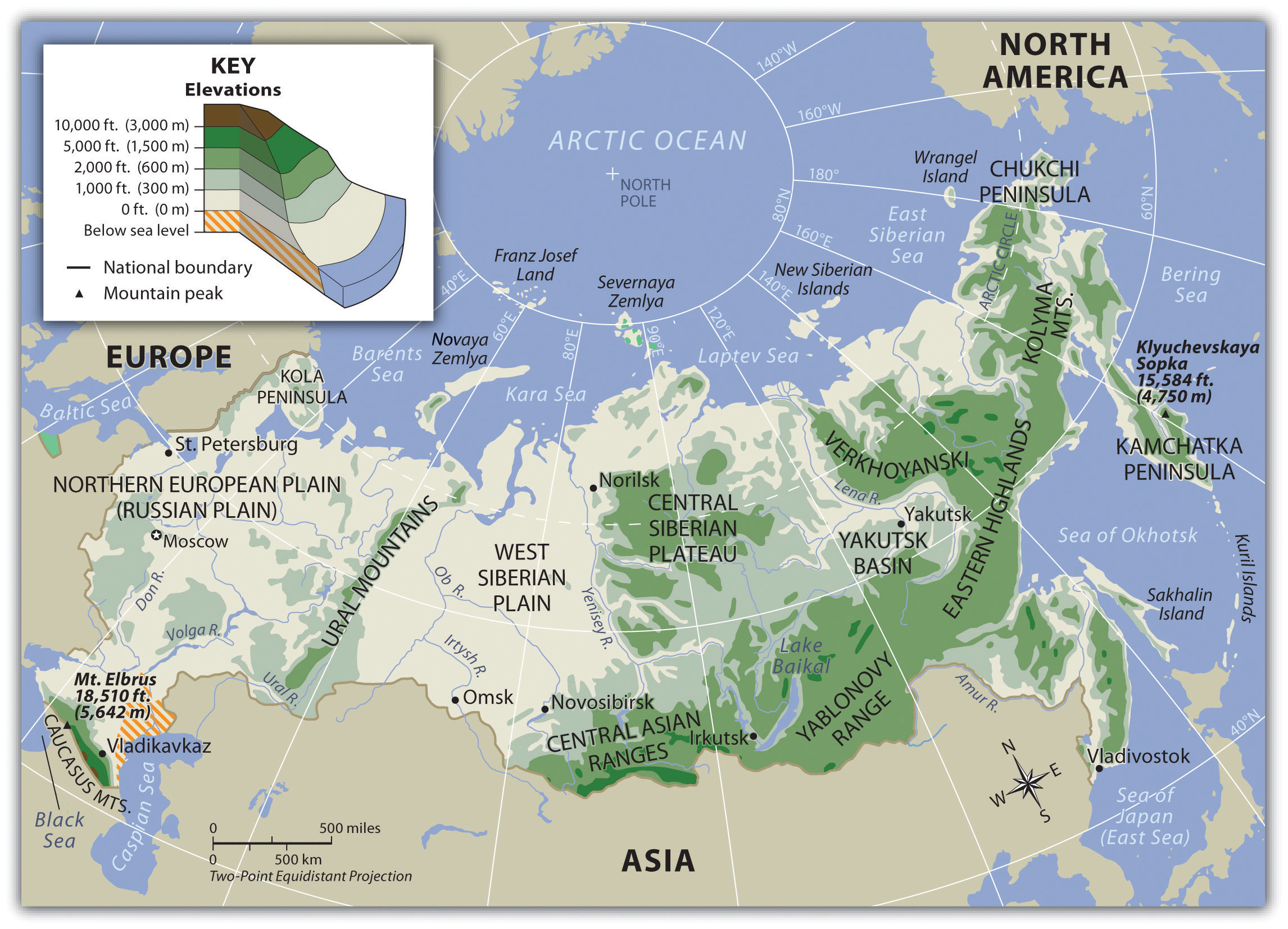Physical Geography of the Region
The massive expanse of Russia exhibits a variety of physical environments, such as tundras, steppes, mountains, and birch forests. Type D (continental) climates dominate most of the country and characterize large landmasses such as Eurasia and North America. Land in the center of a vast continent, far from the moderating effects of oceans, tends to heat up rapidly in the summer and cool down rapidly in the winter. These areas are known for hot summers and cold, harsh winters. Northern Russia borders the Arctic Ocean, and frigid air masses from the Arctic swoop south across Russia each winter. Moreover, Russia’s northerly latitude means that it experiences a short growing season and has never been an agricultural superpower; the country usually has to import grain to feed its people. Mountain ranges to the south block summer rains and warm air masses that would otherwise come from South and Central Asia, thus creating deserts and steppes in southern Russia.

Most of Russia’s population live in the European part of the country on the Eastern European Plain, also known as the Western Russian Plain, or the Russian Plain, the most agriculturally productive land in Russia. The eastern edge of the plain is marked by the Ural Mountains, a low-lying mountain chain (about 6,000 feet) that crosses Russia from the Arctic Ocean to Kazakhstan. The mountains contain deposits of coal, iron ore, and precious and semiprecious stones and are considered the boundary between Europe and Asia. To the south of the Russian Plain is another mountain range, the Caucasus Mountains, which bridges the gap between the Caspian and Black Seas. East of the Urals is the West Siberian Plain, the Central Siberian Plateau, the Yakutsk Basin, the Eastern Highlands, and the Central Asian Ranges. Russia has abundant natural resources, such as petroleum, natural gas, and forest products.
Environmental Problems
Each region of the Russian republic has its own environmental issues. The core region surrounding Moscow, with all its industrial activity and vast urban expanses, introduces sewage and chemicals to the country’s waterways, contributing to serious water pollution. The same water pollution is found east of the Ural Mountains – and in the waterways in that region – because of the industrial cities found there. Moscow and the ring of industrial cities surrounding it have seen a dramatic increase in automobile use since 1991, contributing to air pollution. Russia is blessed with abundant natural resources, but significant environmental damage has been the price of exploiting and extracting those resources. Massive oil spills have occurred in the taiga and tundra areas, where the lack of safety management has increased environmental damage during oil exploration and development. The taiga is the broad expanse of evergreen or boreal forests in the north just south of the tundra in North America, Europe, and Asia. The taiga is most common in type D climates and is one of the most massive biomes on earth. The taiga is the largest biome in Russia. Mining and smelting processes in Siberian cities have added to the region’s air and water pollution. These ecosystems are somewhat fragile and will take years to recover from such damage.
Water pollution from the rivers extends into the Black Sea, the Caspian Sea, and other bodies of water. Lake Baikal, described as the largest freshwater lake in the world, was at one time pristine, but pollutants have entered its waters from nearby industrial activity. Increased pollution in the Black and Caspian Seas, as well as overfishing, the lack of fishing regulations, and the lack of law enforcement, has resulted in the devastation of fish populations such as the caviar-producing sturgeon. The Arctic waters of the Barents Sea off the northern coast of Russia have been a dumping ground for nuclear waste products and expended nuclear reactors from naval vessels. The consequences of this nuclear pollution are not widely known or studied. Many aging nuclear reactors from the Soviet-era dot the landscape, and they will need to be decommissioned at some point, adding to the nuclear waste issues. Various regions in Siberia were used for nuclear testing and are also contaminated with nuclear radiation.
Russia has also be a country that might benefit from a warming planet. As the Arctic Ocean continues to melt, and has a shorter freeze season, access to oil reserves within the region become easier to access. Much of these untapped oil reserves reside along Russia’s continental shelf.
